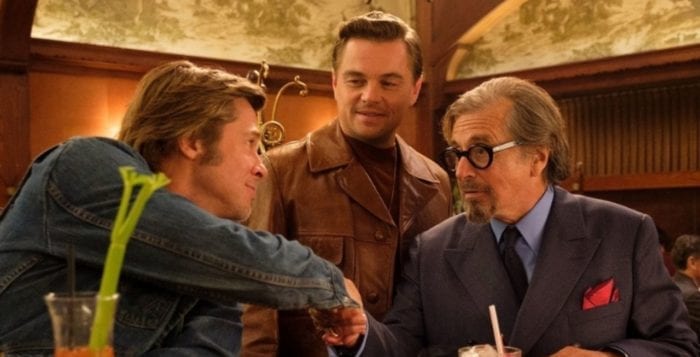Movie Review: Tarantino’s messy, mesmerizing Once Upon a Time … in Hollywood
By Jeffrey Sanzel
When approaching the films of cinematic auteurs, the tendency is to evaluate based on their entire body of work. While there is a logic to this, it is ultimately of limited value to someone actually experiencing the movie. Often, this is the road taken when the film is disappointing or less than the artist’s previous work. Fortunately, in the case of Once Upon a Time … in Hollywood, Quentin Tarantino has written and directed a strange but truly original love letter to the films of the late ’60s, creating a tapestry of real-life events and fictional characters. The upshot is an epic, enthralling, sometimes chaotic, often messy, but (mostly) satisfying journey.

Once Upon a Time interweaves a trio of threads: the fictional story of Rick Dalton (an amazing Leonardo DiCaprio), a TV western star on his way down, and his stuntman-gopher Cliff Booth (Brad Pitt, iconically charming); neighbor Sharon Tate (a luminous Margot Robbie); and the infamous Manson Family. Throughout, the narratives overlap, diverge and finally come together. The film is long but never boring, painting a vivid portrait of the seedier world of Hollywood.
The performances are universally strong. Brad Pitt is warm and easy as the good-guy lackey with a past. His easy façade belies the darker shades beneath. Ultimately, he is the true hero in this world of faux cowboys.
Margot Robbie captures Tate’s innocence. There is an enchanting scene where she attends her most recent film – Dean Martin’s The Wrecking Crew; her face is a wonder as she marvels, childlike, at her own image. With the least dialogue of any of the principals, Robbie manages to capture both Tate’s hopes and fragility. The actors playing members of the Manson Family are appropriately wide-eyed and menacingly mercurial, most notably Margaret Qualley as Pussycat and Damon Herriman, seen only briefly but to great effect, as Charles Manson.
But it is DiCaprio, as the self-destructive Dalton, who is a revelation. The portrait of an actor being pushed from hero to heavy, struggling with the twin demons of inadequacy and alcohol, is spot-on. Whether seen in clips from his ’50s network show Bounty Law, beating himself into a performance, or engaging with an 8-year-old costar (a delightful Julia Butters), he is funny, honest and completely human.
There are assorted cameos and supporting roles from a who’s who of Hollywood, including Al Pacino (sounding surprisingly like Mel Brooks) as a stereotypical Hollywood player; Dakota Fanning, a chilling “Squeaky” Fromme; Bruce Dern as George Spahn, who rented his ranch to the Mason Family; Mike Moh as a hilariously arrogant Bruce Lee; Kurt Russell, low-key as a stunt coordinator and the film’s narrator; Rebecca Gayheart as Booth’s shrewish wife (whom he may or may not have murdered); and the late Luke Perry as TV actor Wayne Maunder, among others.
In its homage to the 1960s, Once Upon a Time is gritty and peripatetic, resulting in a picture that seems to have actually been shot in 1969. Sparing no detail, this is an immersion in a rough, bygone Los Angeles. The film alternates between satire and drama, reality and fiction, often jarringly so. A comedic moment juxtaposed with the tense shadow of the coming murders is clearly and, we assume intentionally, disturbing.
But this is part of the greater whole that Tarantino has shaped in his semifictional Hollywood. There are moments and gimmicks that step out of this world but, fortunately, they are few and Tarantino lets the narrative carry the context. The final 10 minutes (and the only true graphic ones) can be best explained by the title. To say more is to detract from Tarantino’s bold and certainly controversial twist.
Rated R, Once Upon a Time … in Hollywood is an audacious, occasionally maddening film, but one that Tarantino fans – and others – will certainly embrace.







